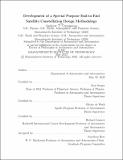Development of a Special Purpose End-to-End Satellite Constellation Design Methodology
Author(s)
Cummings, Andrew T.
DownloadThesis PDF (8.711Mb)
Advisor
Seager, Sara
de Weck, Olivier
Linares, Richard
Terms of use
Metadata
Show full item recordAbstract
Recent improvements in payload delivery to low-Earth orbit (LEO) have significantly improved the capacity to economically deploy satellite constellations. These constellations are profoundly versatile, with the potential to allow researchers to gather large volumes of data from astronomy and Earth-observing missions over an unconstrained mission lifetime. However, many current satellite constellation design methodologies focus on designing satellite constellations with global coverage, rather than constellations with maximized coverage for a smaller, specified area of interest.
This dissertation presents an open-source methodological framework capable of optimizing the design of special purpose satellite constellations for a given mission science objective. We present two case studies that we use to illustrate the framework’s functionality. The first case study is an astronomy constellation, with a science objective that maximizes coverage of a list of target stars so that we can minimize the error of stellar spin-axis inclination retrieval and constrain the spin-axis inclination of FGK spectral-type target stars. The second case study is an Earth-observing constellation designed to minimize revisit time to a specific target area, and achieve better ground sampling precision over existing thermal infrared platforms for the monitoring of thermal emissions over a target area.
Our special purpose framework is robust, modular, and fast, allowing it to serve as an effective reference point for any commercial, scientific, and governmental mission requiring satellite constellation design. We find Pareto optimal satellite constellation architectures for a thermal infrared Earth-observing mission that achieve a minimum revisit time of 8 days for a ground sampling distance of 6.6 m.
Date issued
2023-06Department
Massachusetts Institute of Technology. Department of Aeronautics and AstronauticsPublisher
Massachusetts Institute of Technology